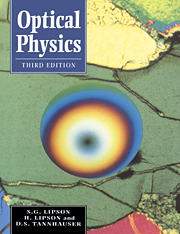Book contents
- Frontmatter
- Contents
- Preface to the third edition
- Preface to the second edition
- Preface to the first edition
- 1 History of ideas
- 2 Waves
- 3 Geometrical optics
- 4 Fourier theory
- 5 Electromagnetic waves
- 6 Polarization and anisotropic media
- 7 Diffraction
- 8 Fraunhofer diffraction and interference
- 9 Interferometry
- 10 Optical waveguides and modulated media
- 11 Coherence
- 12 Image formation
- 13 The classical theory of dispersion
- 14 Quantum optics and lasers
- 15 Problems
- Appendix 1 Bessel functions in wave optics
- Appendix 2 Lecture demonstrations in Fourier optics
- Bibliography
- Index
11 - Coherence
- Frontmatter
- Contents
- Preface to the third edition
- Preface to the second edition
- Preface to the first edition
- 1 History of ideas
- 2 Waves
- 3 Geometrical optics
- 4 Fourier theory
- 5 Electromagnetic waves
- 6 Polarization and anisotropic media
- 7 Diffraction
- 8 Fraunhofer diffraction and interference
- 9 Interferometry
- 10 Optical waveguides and modulated media
- 11 Coherence
- 12 Image formation
- 13 The classical theory of dispersion
- 14 Quantum optics and lasers
- 15 Problems
- Appendix 1 Bessel functions in wave optics
- Appendix 2 Lecture demonstrations in Fourier optics
- Bibliography
- Index
Summary
Introduction
The coherence of a wave describes the accuracy with which it can be represented by a pure sine wave. So far we have discussed optical effects in terms of waves whose wave-vector k and frequency ω can be exactly defined; in this chapter we intend to investigate the way in which uncertainties and small fluctuations in k and ω can affect the observations in optical experiments. Waves that appear to be pure sine waves only if they are observed in a limited space or for a limited period of time are called partially coherent waves, and a considerable part of this chapter will be devoted to developing measures of the deviations of such impure waves from their pure counterparts. These measures of the coherence properties of the waves are functions of both time and space, but in the interests of clarity we shall consider them as functions of each variable independently. Fig. 11.1 illustrates, in a very primitive manner, one wave which is partially coherent in time (it appears to be a perfect sine wave only when observed for a limited time) and a second wave which is partially coherent in space (it appears to be a sinusoidal plane-wave only if observed over a limited region of its wavefront).
The understanding of the coherence properties of light has had numerous practical consequences. Amongst these are the technique of Fourier-transform spectroscopy and several methods of making astronomical measurements with high resolution.
Information
- Type
- Chapter
- Information
- Optical Physics , pp. 290 - 326Publisher: Cambridge University PressPrint publication year: 1995
